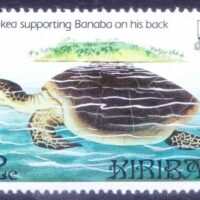Tabakea : The Primordial Turtle
Listen
At a glance
| Description | |
|---|---|
| Origin | Kiribati Mythology |
| Classification | Gods |
| Family Members | Tituabine (Sister) |
| Region | Kiribati |
| Associated With | Creation |
Tabakea
Introduction
In the heart of Kiribati mythology lies Tabakea, a revered turtle deity whose presence symbolizes creation, protection, and cosmic order. Deeply embedded in the cultural consciousness of the I-Kiribati people, Tabakea is not just a divine figure but a living embodiment of ancestral knowledge, nature’s balance, and the spiritual bridge between land and sea. His story reflects the islanders’ profound relationship with their environment, where mythology is more than storytelling—it’s a guide to living in harmony with the world around them. Tabakea is remembered not just as a mythical being, but as a divine architect of existence, central to the origin narratives of both the land and its people.
Physical Traits
Tabakea is most commonly imagined as a giant turtle, a creature deeply symbolic across Pacific cultures. However, he is no ordinary turtle—his mythic portrayal blends physical grandeur with divine luminosity. His shell glimmers with hues resembling the hawksbill turtle, invoking a sense of wonder, durability, and sanctity. At times, he is described as a spirit-man, neither fully human nor fully animal, but rather a fusion of both realms. In more esoteric traditions, he exhibits traits such as shape-shifting, a power that enables him to traverse both land and sea, the physical and the spiritual. This transformative nature reinforces his place as a liminal deity—existing on thresholds, crossing boundaries, and embodying dualities essential to the Kiribati worldview.
Family
The lineage of Tabakea holds a central place in the cosmological hierarchy of Kiribati myths. As the partner of Nei Tituabine—his consort and, in some versions, his sister—Tabakea is said to have fathered a host of powerful deities who played vital roles in shaping the universe. Their divine union, rooted in the sacred island of Banaba, marked the beginning of cosmic structure and familial governance. Among their progeny is Nakaa, a significant spiritual figure who guards the souls of the dead. Another child, Na Areau (sometimes also known as Nareau), emerges as a demiurgic character known for his wisdom and transformation, born through a ritualistic rebirth from Tabakea’s forehead. These offspring carry forth not only the legacy of their creator parents but also represent different domains of spiritual and earthly power. Family clans in modern Kiribati still trace their roots back to this divine lineage, underscoring how myth and ancestry remain inseparable in cultural identity.
Other names
The name Tabakea, also rendered as Tabwakea, is rooted in the Gilbertese word for “turtle,” linking the deity to a creature long revered for its endurance and connection to the ocean. In linguistic and spiritual terms, “te tabakea” is more than a noun—it’s an emblematic concept encompassing both the literal animal and a spiritual archetype. Variants like “Tabakea ae i eta,” meaning spirit turtle, and “Tabakeakea,” used as a verb indicating the act of embodying turtle-like qualities, showcase the linguistic depth surrounding his identity. These iterations highlight not only his divinity but also how the turtle becomes a cultural metaphor for patience, strength, and guardianship. His name even appears in geographical references, such as the village of Tabwakea in Kiritimati (Christmas Island), further rooting his presence in both myth and landscape.
Powers and Abilities
Tabakea’s divine powers reflect his status as a cosmic force. He is a creator of land and life, shaping the world through his union with Nei Tituabine and birthing key figures who would govern natural and spiritual realms. His abilities extend to elemental manipulation—summoning spirits, conjuring devils, and aiding or punishing as needed. One myth describes his intervention during a time of famine, when he dispatched a spirit to help Bakoariki, his adopted son, illustrating his control over unseen forces and his role as a benefactor. Transformation is another key ability, most notably through his shape-shifting between human and turtle forms and through the ritual burning of Na Areau, whom he molded from an ugly lizard into a powerful man. This act, symbolic of initiation and rebirth, is reminiscent of shamanic traditions and echoes human rites of passage. Tabakea’s wrath is equally potent. When defied, he can exile beings to the sea, as seen in myths where Bakoariki’s disobedience led to his banishment—thus giving rise to the eternal journey of sea turtles across ocean and land.
Modern Day Influence
Although modern Kiribati is largely shaped by Christianity, traditional beliefs still permeate aspects of community identity and spiritual life. The name Tabakea endures, notably in the Tabakea Kiribati Protestant Church on Kiritimati, which serves as both a religious center and a cultural anchor for local communities. This naming reflects how mythological figures like Tabakea continue to inspire, even in contemporary religious practice. Beyond religion, his influence persists in oral storytelling, dance, and ritual, keeping the ancestral connection alive in a rapidly changing world. Despite environmental challenges such as rising sea levels and the historical trauma of nuclear testing, Kiritimati remains a vibrant place where tradition and resilience go hand in hand. Tourists visiting Tabwakea village encounter more than scenic beauty—they engage with a living legacy that traces its roots to ancient myth. The continued reverence for Tabakea represents more than nostalgia; it affirms an enduring belief in the sacred harmony between people, land, and sea—a harmony the primordial turtle helped to create and continues to embody.
Related Images
Source
Alexis-Martin, B. (n.d.). Kiritimati and the Bomb: A Tale of Two Churches. Oikoumene. Retrieved from https://www.oikoumene.org/blog/kiritimati-and-the-bomb-a-tale-of-two-churches
Pantheon. (2001, July 1). Tabakea | Facts, Information, and Mythology. Retrieved from https://pantheon.org/articles/t/tabakea.html
Trussel, S. (n.d.). Kiribati – English Dictionary – T. Retrieved from https://www.trussel.com/kir/dic/dic_t.htm
Wikipedia. (n.d.). Tabwakea. Retrieved from https://en.wikipedia.org/wiki/Tabwakea
WorldAtlas. (2018, May 8). The Culture And Traditions Of Kiribati. Retrieved from https://www.worldatlas.com/articles/the-culture-and-traditions-of-kiribati.html
Frequently Asked Questions
What is lorem Ipsum?
I am text block. Click edit button to change this text. Lorem ipsum dolor sit amet, consectetur adipiscing elit. Ut elit tellus, luctus nec ullamcorper mattis, pulvinar dapibus leo.
What is lorem Ipsum?
I am text block. Click edit button to change this text. Lorem ipsum dolor sit amet, consectetur adipiscing elit. Ut elit tellus, luctus nec ullamcorper mattis, pulvinar dapibus leo.
What is lorem Ipsum?
I am text block. Click edit button to change this text. Lorem ipsum dolor sit amet, consectetur adipiscing elit. Ut elit tellus, luctus nec ullamcorper mattis, pulvinar dapibus leo.
What is lorem Ipsum?
I am text block. Click edit button to change this text. Lorem ipsum dolor sit amet, consectetur adipiscing elit. Ut elit tellus, luctus nec ullamcorper mattis, pulvinar dapibus leo.
What is lorem Ipsum?
I am text block. Click edit button to change this text. Lorem ipsum dolor sit amet, consectetur adipiscing elit. Ut elit tellus, luctus nec ullamcorper mattis, pulvinar dapibus leo.







